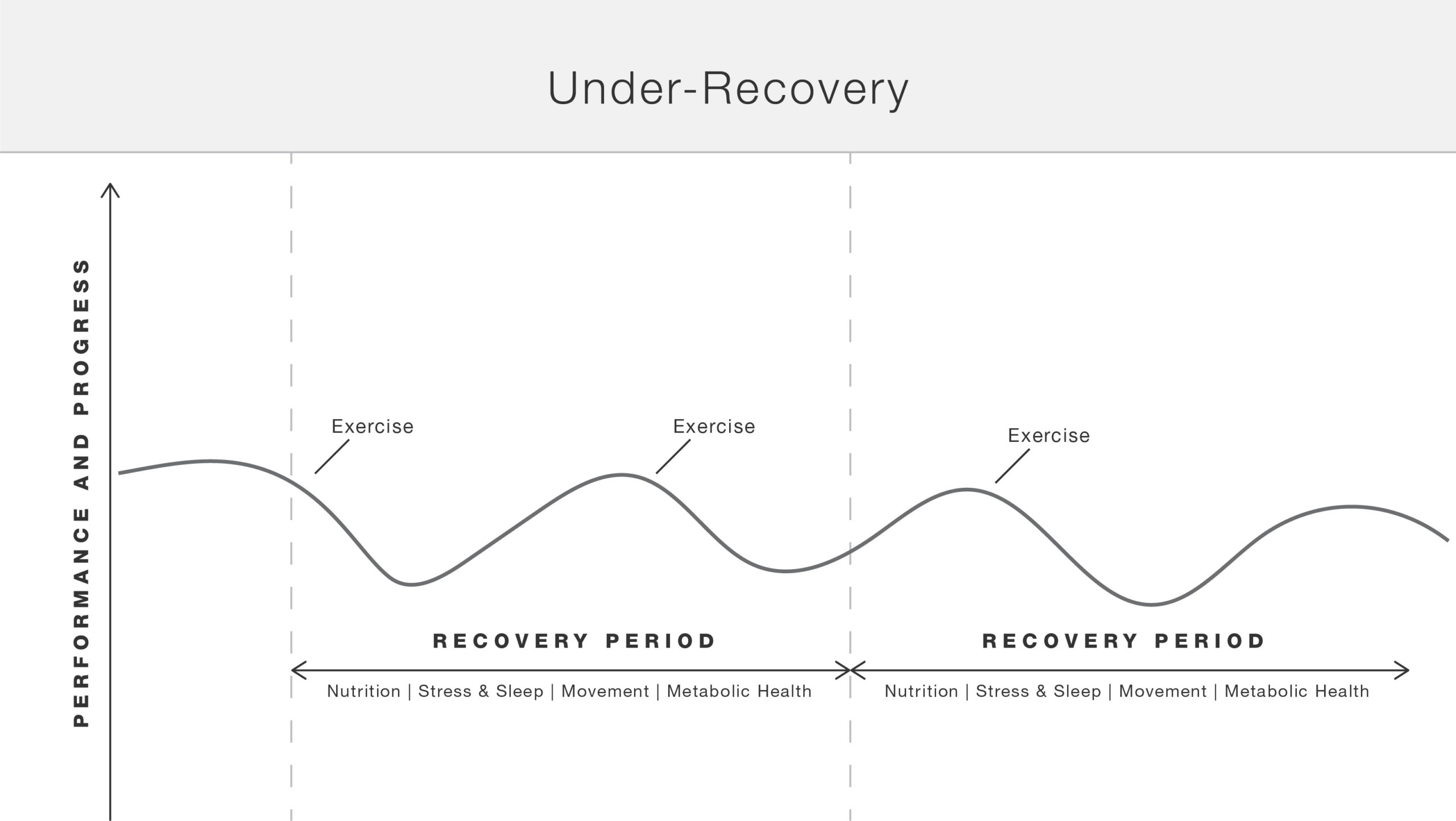After more than a decade in the fitness and nutrition industry, I’ve learned that the most common belief many people have when it comes to exercise is that the harder they work, the fitter and healthier they’ll be. Exercise should be hard if you want to change — no pain, no gain, right?
As it turns out, this outlook is only partially true, and without question, incomplete. Yes, pushing yourself and facing fitness challenges are necessary if you want to experience positive changes.
Yet some of the hardest working gymgoers struggle to see the muscle gain, fat loss, and wellness improvements they’re hoping for — and inadequate recovery may be the reason for their lack of success.
Discover why fitness recovery needs to be a non-negotiable part of your routine — along with some tangible ways to effectively implement it.
Exercise as a (Good) Stressor
Stress is a natural part of the human experience, and there are complex processes in place — such as those occurring in the adrenal glands and hormones such as cortisol and adrenaline — to help our bodies adapt and stay resilient.
Our systems respond and adapt to the cumulative stress we experience, including from job responsibilities, family demands, relationships, finances, lack of adequate sleep, nutrient deficiencies, environmental-pollutant exposure, excess intake of processed foods or alcohol, and exercise. It can be helpful to think of it as though they’re all contributing to the same stress “bucket”; if it overflows, not only does progress in fitness stall, but metabolic and health problems can result as well.
Exercise is a necessary source of stress — there’s no such thing as optimal health without it. But it does need to be managed and recovered from to come back stronger.
The Concern about Under-Recovery
“You can only progress as hard as you recover,” is one of the most common phrases I repeat with my training clients. A tough workout as part of a broader exercise program is meant to break you down (in a controlled, not chaotic manner), not build you up during the workout itself. The magic happens between sessions if the right recovery strategy is in place.
Chronic intense exercise without the proper tools needed to heal, strengthen, and adapt between those sessions leads to under-recovery and stalled progress. These tools include restorative, lower-intensity sessions and movements, nutrition to refuel, dialed-in sleep patterns, and optimization of underlying health and hormones.
Without them, your exercise sessions can become just another stress to add to the bucket. As a result, your performance and progress may decline.

To avoid this and instead make the most of your exercise efforts, it’s important to prioritize the following.
1. Incorporate purposeful, restorative sessions.
As you develop your exercise plan, build in lower-intensity days that give you a break from the adrenaline-pumping, heart-pounding, high-intensity workouts. The day or two after a planned, challenging workout, focus on activities that keep you moving — and your circulation going — without adding stress to your body. This includes both active recovery and passive recovery.
- Active recovery keeps you moving — without adding additional stress to the system. Think lower-intensity cardio, such as walking, biking, or elliptical training at a slower pace (you should be able to hold a conversation without feeling breathless); this increases circulation without taxing your system. Incorporating a lower-intensity Pilates reformer session or a gentle yoga class (such as Life Time’s ROOT fundamentals or SURRENDER yin) are fantastic options as well. Practicing movements to improve hip mobility (critical for addressing back pain), foam rolling, and unloaded body-weight strength movements through the proper range of motion are all helpful, too. Aim to include active recovery one to three days per week based on your training volume, leaning toward the more frequent end the more often you train.
- Passive recovery involves rest and little to no movement, and usually follows particularly challenging workouts or athletic events. However, you still want to enhance circulation to support muscle healing. The most common techniques include strategies such as massage and hydromassage, sauna use, NormaTec® compression, or Hyperice® vibration therapy. All of these support your body’s parasympathetic nervous system, which is responsible for our neurological “rest” state. Depending on your routine, aim to do some form of passive recovery one to two times per week.
For adrenaline junkies, it may initially feel like you’re not “working out.” Remember, though: You’re moving in a way to better prepare your body for your next higher intensity session.
2. Use nutrition to refuel.
When muscles are broken down and the neurological and respiratory systems are taxed, your body requires nutrients and raw materials to rebuild muscle fibers and replenish glycogen (stored carbohydrate) reserves. Without this, strength and lean-mass gains will suffer — and your sleep quality will likely take a downturn as well.
At the most fundamental level, be sure that your nutrition directly before and after exercise is addressed. (For more on this, check out “Workout Nutrition Hacks.”) Outside of workout nutrition, your day-to-day choices will significantly affect your fitness as well.
Calorie sufficiency is key, even for those with a fat-loss goal. There is such thing as a too-severe calorie deficit, and dropping intake too low will activate the body’s complex stress-adaptation survival response, shifting hormones unfavorably to compensate for the gap; this can prevent fat loss. Slow, steady, and reasonable are the best approaches to take.
Ample, adequate protein is a baseline requirement to provide the amino-acid building blocks for muscles to build and strengthen. A solid target for most people to aim for is approximately one gram of protein per pound of goal body weight. The best sources include meat, fish, poultry, eggs, and dairy from healthy animals raised sustainably and on their natural diets. Aim to include them at every meal.
Quality-tested protein powders with free of unnecessary additives, such as those offered through Life Time’s protein lineup, are a convenient way to boost protein as well, especially to those who are short on time or need a boost.
While it’s impossible to get into every nutrition strategy here, such as the importance of adequate vegetable, fiber, and produce intake, along with core supplementation (particularly omega-3 fatty acids from fish oil), the above offers a good start.
3. Dial in your sleep patterns.
Without question, sleep is one of the most important and undervalued secrets to recovery. Through different phases of sleep, your body releases a cocktail of hormones, such as growth hormone, and activates processes to enhance vitality and healing from your workout regimen.
In athletes who I’ve worked with, performance has always gone hand-in-hand with sleep patterns. As athletic demands and training schedules increase, so does the focus and prioritization of extra nighttime rest. Even if you’re not an athlete, this example highlights the interplay between proper rest and the ability to come back and perform at your best.
If you’ve been short-changing sleep time for a couple of extra episodes of your favorite TV show or a social-media scroll session, it may be time to implement some boundaries around bedtime. The negative effects of mounting sleep debt are unavoidable. (For more on sleep and how to optimize it, see “Sleep: Your Guide to a Better Brain and Body.”)
4. Work to optimize underlying health and hormones.
At Life Time, we believe that what’s going on under the hood with your health is just as, if not more important than, what’s happening on the outside. Time and again, we’ve seen that a book cannot be judged by its cover, and we have a passion for optimizing your health and well-being from the inside-out.
In terms of fitness recovery, imbalances in blood sugar and hormones like cortisol and testosterone — along with nutrients such as vitamin D, magnesium, zinc, and B-vitamins — can all play a significant role.
For example, high cortisol levels (from unmanaged stress or under-recovery) contribute to fat gain and breakdown of muscle. Below-optimal magnesium levels (the most common mineral deficiency) can lead to muscle cramping and tightness. When B-vitamin levels are low, fatigue and exhaustion are common, making it harder to push yourself and perform.
Even for those without diagnosable medical conditions, subtle shifts in these health metrics can still affect how you feel, function, and perform. This is part of the reason we often recommend a comprehensive, in-depth assessment of your health, performed annually. The more you know, the more you can optimize your approach.
Whether you’re a seasoned exerciser or a newbie to the fitness space, your recovery matters. While the challenge and intensity of hard workouts and demanding exercise programs are necessary to drive positive change and adaptation, those changes will remain elusive (or at the very least, stall out and plateau) if you don’t give your body and metabolism some love and recovery.
By purposely incorporating more active and passive recovery to your routine, refueling with the right nutrients, prioritizing adequate rest at night, and monitoring and optimizing your internal health, you’ll be better able to achieve your highest level of fitness potential.




